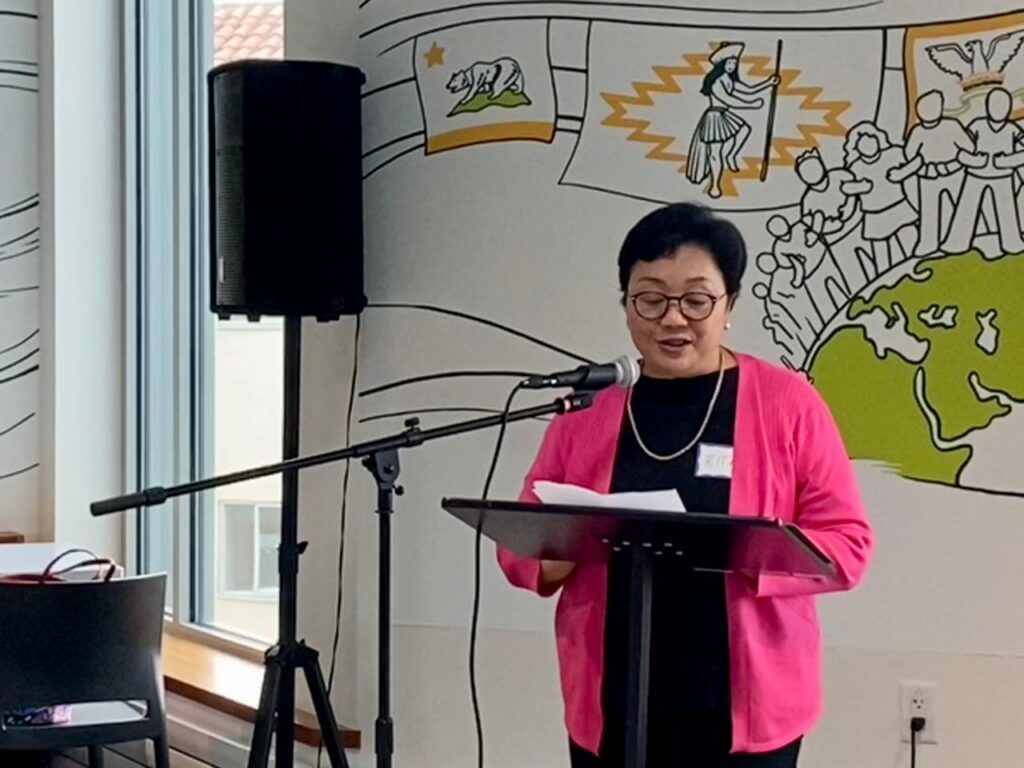Straight from the authors
Ms Rita Atienza
Speech at the McGrath dinner on 29 June 2023


On 29 June 2023, at a formal dinner in honor of Bob and Joan McGrath at the Koret Lodge, University of San Francisco, Rita Atienza, co-author of Learning by Refraction, was invited to speak about the value of Ignatian Pedagogy in today’s world. Here is what she shared.
In the Philippines, where 80% of the population is Catholic, there are hardly any graduate programs on Catholic Education or on Catholic Educational Leadership. Theology or Religious Education, yes, but not Catholic Education. Because of this, I was quite disoriented when I was first considering joining the CEL program. A doctorate in Catholic Educational Leadership? There is THAT MUCH to study about it? Really? To run a Catholic school well, can’t an administrator just take an EdD on Educational Leadership in general, as is done in the Philippines? And as I thought about it more, I realized that there is still indeed so much that needs to be studied about Philippine Catholic Education.
For example, I thought about how the big C Church has often gotten in the way of making a small c church come alive and flourish in our Catholic schools. In the Philippines, elementary, secondary, and higher education students have exams and receive grades for Religion or Theology classes. At the Ateneo de Manila University, a Jesuit university where I work, all students are required to take 12 units of Theology and 12 units of Philosophy as part of the Core Curriculum. Many students in our Catholic schools are required to do service or social justice immersions to pass each grade level. These are often graded activities. For elementary and secondary levels, students are required to attend campus liturgies. For many students then, Catholic education just equates with requirements to comply with.
How might we transform Catholic education so that it connects more with the realities, challenges, aspirations of our youth? As an educator in a Jesuit school, I believe that the Ignatian Pedagogical Paradigm (also known as the IPP) might be able to provide some entry points for Catholic educators to think about how we might transform Catholic education. The IPP is a teaching framework used in Jesuit schools since 1993, but which I believe can be used by Jesuit and non-Jesuit schools all over the world. The IPP is a model for designing teaching and learning with 5 elements—context, experience, reflection, action, and evaluation.
The IPP tells us that our teaching and our students’ learning must always be relevant to the CONTEXT of the students and the world they live in. Conversations of school leaders and faculty about transformative education could revolve around the contexts of our students today.
Today’s world is a chaotic, complex, and uncertain world. Because of the internet and social media, children today are not shielded from the chaos and violence happening around them. The Context question for Catholic school leaders and faculty to discuss could be on how we could make learning relevant, meaningful, authentic—and small c catholic—for our students who live in such a hostile world. In the Philippines, for example, teachers in Catholic schools hesitate to make references to—much less go into a deeper discussion of—sensitive and controversial issues because, to be honest, we teachers don’t really know how to handle such conversations. But students need to have opportunities to REFLECT on issues such as these. REFLECTION is a critical IPP element. It refers to giving students many opportunities to grapple with the essential questions and big ideas related to events, phenomena, subject matter. So how can student contexts and lived experiences be reflected on in the classroom—not by glossing over them or using motherhood statements and generalities—but in ways that contribute to student well-being and have an impact on the community?
The IPP element of ACTION may provide another entry point for these conversations. Action means that Ignatian education aims to ensure that students to wisely use and ACT ON what they have learned, even beyond the classroom. Catholic school leaders and faculty may discuss the following ACTION question—“How can we better prepare our students TO EMBRACE AND PRACTICE THEIR BEING CATHOLIC in a chaotic, complex, and uncertain world? to BE, to LIVE, to respond as CATHOLICS in a volatile world?
But is this even the right question? Should the Action question be something more like: How can a Catholic learning environment (small C Catholic) awaken the deep potential in all our students—Catholic or not—so that they will be able to live joyfully in this chaotic world and, in the words of Parker Palmer and Arthur Zajonc, live creatively in it, in solitude and in community”?.
I end by telling you about a program called the Pathways to Higher Education at our university, which hopes to support scholars so that they can complete their tertiary education. We learned in Dr. Duffy’s class that access through scholarships does not guarantee that they will complete their tertiary education. Pathways was established in 2002 with a grant from the Ford Foundation. It seeks out students from low-income families while they are in Grade 12 and adopts them into a supportive community and network that provides college adjustment support programs, a global leadership formation program, and mentoring with professionals and practitioners which continues throughout their undergraduate programs and even when they start looking for jobs. In 2021, there were 200 PHE scholars to the Ateneo and to other universities in Metro Manila and over 350 alumni who are now professionals and/or are gainfully employed in various fields. In a 2018 impact assessment study commissioned by PHE which looked into life narratives of selected PHE alumni before, during, and after the Program, the PHE experience was described by one subject as transformative. Some of the key themes that surfaced were: “(1) continuous process of self-development guided by the program’s core values, (2) having a strong sense of self-awareness as part of their life toolkit, (3) developing a mindset of asking for help and dreaming big dreams, and (4) developing a leader identity, defined in one’s own terms” (PSSP, 2019, p. 21).
One can see all five elements of the IPP at play in the Pathways model. The Action they have aimed for and succeeded in achieving—getting these students on the path to truly believing in themselves and achieving their deep potential—is clear. Students have many experiences that allow them to reflect on why and how they can pursue their aspirations—all very cognizant of each student’s individual context and the context of the world in which we live. I hope that the 5 elements of the IPP may also be of value to you as entry points to reflections in your schools on how we can transform Catholic education. Thank you.
